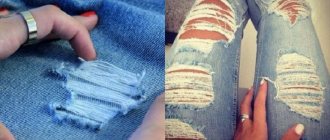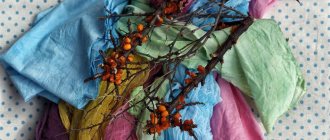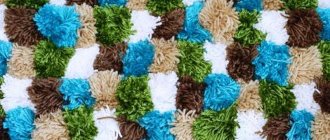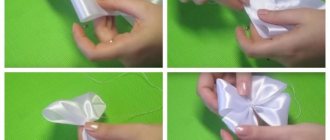Can you dye fabric with egg dye?
But such a product cannot be washed. It is possible to dye fabric with coloring compounds intended for other purposes (dyes for Easter eggs, hair dye), but color fastness will be significantly lower.
Interesting materials:
Why can’t you swim after Ivan Kupala? Why does it itch after a mosquito bite? Why do stains remain on my down jacket after washing? Why is legal nihilism the most dangerous for society? Why is there anemia in chronic kidney disease? Why does meat taste bitter when smoked? Why is the space so long? Why do Class 5 volcanic eruptions occur? Why do power surges occur? Why does agglutination occur?
Details
If you decide to redye the fabric
to a different color at home, your actions and choice of dye will depend on the type of material and the desired final shade of the garment.
Natural fabrics, for example, cotton, linen, chintz, are dyed easily and evenly. Synthetic and mixed ones are more difficult to paint; the result may turn out to be much paler than expected, since the dyeing solution will drain from artificial fibers, like the liquid of plastic bags, without wetting them. Wool is also capricious when dyeing; chemical dyeing solutions can turn its fibers into hard and brittle “twigs”.
IMPORTANT:
Any chemical dye composition (acrylic, aniline paint) can provoke allergic reactions in humans and harm the appearance of the garment being dyed.
Therefore, recipes for dyeing fabrics with natural dyes are becoming increasingly popular. These are plant extracts or powders from dried plant parts.
- So, to give things at home dark and black shades, strong coffee is suitable.
- To obtain a gray shade, broom or bearberry extract is suitable.
- A rich purple can be achieved by using enough blackberries or blueberries.
- Red hues are given to the fabric by beets, wolfberries and elderberries.
- beige in color when using walnut shells and partitions.
- A brownish tint will be obtained by using onion peels and nut shells, cocoa powder, and tea.
- The orange hue comes from citrus zest, sea buckthorn and fresh celandine juice.
- for yellow , as well as carrots.
- The leaves of spinach, sorrel, and elderberry will turn green .
IMPORTANT:
Natural natural dyes are less durable
and the intended shade after dyeing is not always guaranteed. But their advantage is that they are hypoallergenic and suitable for people with sensitive skin and allergic diseases.
Using natural dyes, they are diluted in water, calculating a sufficient amount for the item being dyed. Place the product in the dyeing solution, and the container with the solution is then heated to 600 C. The dyeing period is at least 40 minutes.
Is it possible to dye clothes with hair dye??
Hair dye is often used to color wardrobe items. The danger is that such dyeing compositions were created for other types of fibers and may not cope with the fabric: as a result, the material may be colored unevenly, or the overall color may not be as rich in color as expected. This especially often happens when using dark coloring pigments on fabrics that are already fairly faded from time and frequent use. There is a danger that if you handle the paint carelessly, the fabric of your clothing will become pockmarked and spotted.
IMPORTANT:
Regardless of the dye chosen, after the first and second wash, the dyed garment will fade a lot. Then the paint should set.
Features of dyeing different types of fabric
Cotton and linen
Natural materials are the most amenable to re-dyeing, and they are easy to paint with high quality even at home. For the procedure, it is better to use soft water; it is recommended to add soda to tap water to soften it. To reduce the percentage of shedding subsequently, add a spoonful of salt to the solution during dyeing, and vinegar when rinsing.
IMPORTANT:
If it occurs to you to re-dye a new cotton or linen item you just bought in a store, check that it is probably saturated with starch. Therefore, before dyeing, you must definitely wash it and, most importantly, thoroughly rinse the starch from the fibers of the fabric.
Silk
Dissolve the paste paint intended for silk fabrics little by little in warm water. Then strain thoroughly through cheesecloth. Dissolve a spoonful of salt in the resulting liquid. Stir thoroughly. Pour the resulting solution into a container of sufficient volume and place the item to be dyed in it. Bring to a boil and do not remove from heat for 40 minutes. Rinse in warm and then in cold water.
Synthetics
To dye synthetic fabric with high quality, use industrial permanent dyes, the annotations of which indicate that they are suitable for synthetic fibers. Many types of synthetic materials are simply not able to absorb color pigments. For reliable results, formic acid is added to the solution with the dye. Then the item is placed in a container with this solution and boiled over low heat at a temperature of about 400 C. The item should be rinsed in cool water.
Viscose
Mix hot water with the dye and add a spoonful of salt. Then boil half of the solution and place the garment to be dyed in it. After a quarter of an hour, pour in the second half of the solution. Boil over very low heat for another half hour.
IMPORTANT:
When drying wool after dyeing, do not hang it on hangers or throw it over a rope. To avoid stretching and deformation, woolen clothes are dried by gently stretching them on a horizontal plane, such as a kitchen table, covered with a large terry towel.
How to dye clothes in a washing machine?
Dilute the dye in ½ liter of water heated to 40-50 0. Turn clothing items inside out. Pour the resulting dye solution into the washing machine. Place the items in the drum and run the wash for about 30 minutes at 60 degrees. To fix the color, wash clothes at 40 degrees. At the end of the cycle, it would be good to rinse the clothes in clean warm water with the addition of vinegar.
Source of the article: https://kakchistim.ru/uhod-za-veshchami/odezhda/v-poiskax-cveta-kak-perekrasit-predmety-garderoba-svoimi-rukami.html
Coloring of products
The type of clothing dye you use at home depends on the item.
- combine PVA glue and gouache in half; apply a design to the material with a brush; When changing colors, thoroughly wipe the brush; For a three-dimensional pattern, press lightly; for a flat pattern, press in.
How to dye corduroy pants:
- use purchased dye according to the instructions; fix the result with a vinegar solution at the rate of 1 spoon per 5 liters.
2 How to dye a cotton shirt: like any other cotton item. In soft water, fixing the result with vinegar solution.
3 How to paint a synthetic dress: use disperse paint. Other dyes will not be absorbed, will run off, and streaks may remain.
4 Is it possible to dye a chiffon dress? It is better to take such a delicate item to the dry cleaner for painting. A chiffon blouse should also be protected from independent experiments.
5 A white dress made of natural material can be colored with any pigment. You can try natural dyes. Blueberries and blackberries will help color them blue or deep purple. Folk remedies can easily dye thin fabrics made from natural fibers.
How to dye a towel at home:
- dilute permanent paint according to instructions; pour 10 liters of water and boil; Throw a towel into boiling water and cook for an hour until the fabric turns a different color; rinse thoroughly several times in warm and cold water; fix the result with vinegar.
It is better to paint jeans or other natural materials blue. It is not persistent, but does not spoil the structure of the fibers.
Preparation
Preparing to paint things at home:
- You will need a clean canvas. It is thoroughly washed and rinsed. There should be no detergent left. It will react with the dye, the result will be unpredictable.
- Before washing and subsequent dyeing of the fabric, stains must be removed. With them the color will be uneven. A non-aggressive stain remover is needed.
- For intensity, the material is boiled for 10 minutes or bleached before the process.
- It is necessary to remove all unnecessary objects: buttons, snaps, and remove the metal lock. Painting the fabric will ruin them and may cause rust in the future.
- What paint can be used to paint different colors of materials? Light and white clothes lend themselves to all shades. Colored - only dark, but can be pre-bleached. How to dye fabric at home? Black products will first have to be bleached for a long time, this can damage the structure of the fibers. To turn a black item made from natural fibers into a gray color, it is enough to boil it several times with an aggressive powder. You can add just a little bleach.
- Natural fabric is easy to paint. It's easy to dye cotton, wool or linen at home. They quickly absorb paint and do not fade. Finished synthetic products are almost not painted. Chemical fibers are colored at the initial stages of production. You will need special paint for synthetics.
- A new linen or cotton item is saturated with starch. Before dyeing clothes, it must be removed. Make a solution of soap and soda and boil for twenty minutes. Then rinse to remove all excess substances.
- Wool yarn is rolled into skeins and tied with rope in several places. It shouldn't get tangled in the process. For convenient turning over, the skeins are strung on a rope.
- Fabric dyeing is done in distilled water. Tap water is softened by adding a teaspoon of soda per ten liters.
The amount of dye depends on the weight of the product. How to paint things with paint is described below.
Inventory preparation
To paint things you will need:
- Enameled or glass fireproof container. There should be no chipped pieces. Before using aluminum or galvanized basins, scale must be removed from them.
- The size of the dish should allow the product to float freely without creasing. Fabric dye will not absorb evenly.
- To mix the paint and turn things over, you will need two wooden sticks. They are pre-cleaned of knots/irregularities.
- Scales or measuring cup/spoon and paper towels are required.
Dyeing different materials
In order not to make a mistake with the choice of dye and method, it is worth learning how to dye fabric at home.
Cotton
It fades quickly and fades. You will need durable cotton dye and soft water, melt or rain. How to dye cotton fabric:
- store-bought product is diluted in accordance with the specified proportions; the composition is heated to 50 degrees, the item is poured; cook for 20 minutes, add calcined salt; continue cooking for 35 minutes; take out and rinse with warm water.
At the end, the cotton fabric is rinsed at a cool temperature with the addition of a 5 liter spoon of vinegar.
How to dye a cotton jacket: the principle is the same, but add a few tablespoons of salt after boiling. This is necessary to reduce shedding.
Fabric paint, how to use with flax fibers:
- throw the pigment into the water and mix; place the item and cook for half an hour with the addition of a spoonful of salt; the finished product is rinsed with cold water and vinegar; it is wrung out and laid out on a towel.
How to dye wool
How to dye: Aniline dye is best.
How to dye a woolen item at home:
- one sachet is dissolved in 0.5 liters of water; add warm water to the composition; place the product in the container and wait until it boils; after 25 minutes, add 75 ml of acetic acid.
How to dye fabric brown: boil it in onion peels at the rate of 400 g of peel per 100 wool. Rinse in the same way.
The finished clothes are placed over the bathtub/basin and left so that the bulk of the dyeing liquid is glassed off. Then rinse with cold water. The last rinse is accompanied by lemon juice.
How to dye cashmere: the rules are the same, but use a special dye marked “for wool.” However, it is better to take such a delicate item to the dry cleaner.
Dyeing of silk products:
- wash new material in case it is soaked in something; dilute the dye slowly with water, adding a little liquid to form a thick paste; pour the product into 0.5 liters of water, stir and strain through a clean cloth; dilute according to instructions; to dye a silk skirt or dress faster, add a spoonful of salt per liter; the composition is boiled, the heat is reduced and the clothes are placed; after 30-40 minutes, turn off the stove and leave the item in the pan for half an hour.
Freshly dyed fabric is washed at a hot temperature many times, and finally at a cold temperature.
Synthetics
How to dye synthetic fabric:
- dilute 20 ml of formic acid 85% in 10 liters of water; the dye is dissolved in the composition; stir thoroughly and place the synthetic product; cook at a temperature of 40-45 degrees, no more; After half an hour, rinse with cold water.
The dye for tulle should be durable and bright. This polyester material does not absorb pigment easily. Tulle can be starched for dye fastness.
Polyester
- soak clothes with washing powder for half an hour at temperatures up to 40 degrees; rinse with the addition of ammonia; use only a special dye for polyester, diluted strictly according to the instructions; the time and method indicated on the packaging differ from one manufacturer to another.
In order not to spoil a synthetic item, you must completely follow the instructions and not use natural dyes. Faded fabric made from polyester fibers is easier to dye.
Viscose
How to dye viscose at home:
- combine the dye and calcined salt; paint for artificial fabric is the same as for natural fabric; dilute in hot water; put half of the liquid into a pan, place viscose material; slowly bring to a boil, add a little salt; after a quarter of an hour, they take out the item, pour the second half of the dye into the dish; How to dye viscose fabric further: boil for 20-30 minutes.
An unevenly colored item is rinsed in a powder solution, then in clean water.
General information
But whatever the fabric - natural, synthetic, the general recommendations are as follows:
- The item of clothing must be cleanly washed and free of stains, otherwise the paint may not adhere to the spot where they are located. And this area will stand out unfavorably on clothing.
- Weigh the product. For high-quality dyeing, the proportions of the dye composition must be strictly observed, which are determined based on the weight parameters of the clothing.
- While dyeing, remove buttons and decorative elements from the item.
- Choose options for the resulting shade that are close to the original, and not contrasting; the coloring matter can cope with such a fundamental task.
- Make a trial version - dye a piece of fabric similar to the material of the item.
- Use protective gloves when working with the dye.
- Strictly follow the instructions on the paint packaging. Measuring the weight and duration of paint “by eye” is tantamount to failure.











